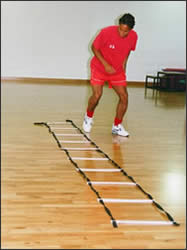Background
Plyometric drills decrease the reaction time of the nervous system in response to external stimuli. This allows the muscles to contract faster to prevent falling or twisting an ankle. The technique was first used during the 1960s and ’70s by eastern European athletes, who organised hopping and jumping techniques into specific plyometric drills.
As the athlete plants their foot before jumping, the muscle that will produce the jump is stretched. As the muscle contracts, the pre-stretched energy is released, producing kinetic energy (movement) which enhances muscle power. By doing plyometric drills the time taken for the stretch to be converted into kinetic energy is decreased.
Before initiating plyometric activities there must be a sound strength base, otherwise, the risk of injury is increased. As a general rule the athlete should be comfortable in squatting 60% of their body weight, at a rate of 5 repetitions in 5 seconds, before these exercises are commenced. The athlete should be able to stand on one leg, with eyes both open and shut, for 30 seconds and should be able to long jump the distance of their own height.
Ideally, plyometric training should be done under the supervision of a trainer or chartered physiotherapist.
Quick Feet Drills
Quick feet drills using a rope ladder are a form of plyometric activity. Lateral (sideways) movements are functional for most sports, including soccer…

The progression is to multi-directional patterns using the rope ladder, moving from left to right while contacting each square with both feet…

then back, from right to left…

continuing the sideways pattern. Note the muscle work in the quads to control the movement. This lateral exercise puts a controlled load through the collateral ligaments of the knees and ankles.

Forward Jump Drills
Double-footed forward jumps over a 30cm barrier.
After some practice, the three barriers should be cleared as quickly as possible…
The progression of this exercise is to do it using one leg…
and again, after some practice, the hurdles should be cleared as quickly as possible.
Cross Jump Drills
Cross jumps help to train power. The starting position is with one leg in front and the other behind.
Power is generated through a vertical jump…
with the front leg moved back and the back leg moved forward to land.
Box Jump Drills
Double-footed box jumps encourage explosive power. Note the use of the arms to help generate force.
and the landing is controlled by eccentric muscle work.
Consecutive box jumps can be undertaken using a sequence of boxes.
then back on…
Multi-Directional Jump Drills
The progression from straight-line jumps is multi-directional jumps and, as an advanced exercise, multi-directional jumps can be done on one leg…
Using a trampette, the player hops off…
and then back on…
then off, moving around the trampette.
The post Ankle Plyometrics appeared first on PhysioRoom Advice.